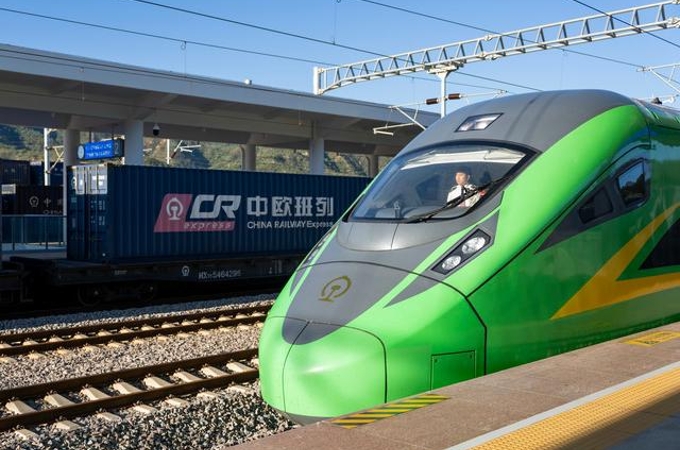Country to launch 14th manned space flight
Source: China Daily | 2024-10-23 | Editor:Reena

The Shenzhou XIX crew spacecraft and its carrier, a Long March 2F rocket, are moved to the service tower at Jiuquan Satellite Launch Center on Tuesday. LI DONG/FOR CHINA DAILY
The Shenzhou XIX spacecraft, China's next manned mission, is scheduled to be launched in the coming days to transport three astronauts to the Tiangong space station, according to plans announced by the China Manned Space Agency.
The mission crew's spacecraft and its carrier, a Long March 2F rocket, were moved to the service tower on Tuesday afternoon at the Jiuquan Satellite Launch Center in northwestern China's Gobi Desert, the agency said in a brief news release, adding that the launch equipment at the spaceport "is in good condition".
The release noted that the spacecraft and rocket will undergo final functional checks over the next several days. It said the launch will take place in due course.
The Shenzhou XIX crew will carry out China's 14th manned spaceflight and will become the eighth group of inhabitants of the Tiangong.
The crew members, whose names have yet to be disclosed, will take over the massive orbital outpost from their peers — mission commander Senior Colonel Ye Guangfu and crew members Lieutenant Colonel Li Guangsu and Lieutenant Colonel Li Cong — who arrived on April 26 with the Shenzhou XVIII mission. By the end of October, Ye's team will have been in orbit for six months.
Wang Yanan, chief editor of Aerospace Magazine, said the Shenzhou XIX astronauts will likely be tasked with conducting scientific experiments and technological tests that will be more sophisticated and challenging than those performed by their peers in previous missions.
"In the first two years since the Tiangong started formal operation, astronauts would not be given very complex science and technology assignments because their primary tasks were to explore living and work patterns that most fit them and to check whether the massive station could function well," he said.
"Now, as Chinese astronauts have gotten used to living inside the station and well understand its long-term orbital flight pattern, the newcomers will be given more challenging tasks, namely to conduct difficult science and technology operations," he said.
Completed in late 2022, Tiangong is one of the largest and most complex structures ever established in space by humankind.
Orbiting Earth at a distance of about 400 kilometers, the Chinese station has three permanent parts — a core module and two science capsules — and is regularly connected to several visiting crew and cargo spaceships.
You May Like
-
Key facilities enable scientific advancement
Over the past 75 years, China's development of key scientific facilities has advanced in leaps and bounds, most notably in the past several decades as the Chine...
InKunming 2024-10-15 -
China's self-developed airship harvests wind power at record...
China's domestically developed buoyant airborne turbine reached a record height on Thursday in Central China's Hubei province, harnessing stronger, steadier win...
InKunming 2024-10-14 -
Atmospheric monitor marks 30 years
For the past 30 years, researchers based at the peak of Mount Waliguan in Northwest China's Qinghai province have worked around the clock to monitor the atmosph...
InKunming 2024-10-14 -
China's first reusable satellite returns to Earth with paylo...
China's first reusable satellite returns to Earth with payloads on Oct 11, 2024.
InKunming 2024-10-12 -
Innovation spurs Chinese tech firms' earnings in global mark...
It took Chinese entrepreneur Zhang Junbin eight years to transform a small startup with just 200,000 yuan (about 28,272 U.S. dollars) in initial capital into ...
InKunming 2024-10-12 -
Xi extends greetings to elderly to mark Seniors' Day
President Xi Jinping extended greetings to the elderly ahead of the country's Seniors' Day, which falls on Friday, and he called on the silver-haired group nati...
InKunming 2024-10-11 -
Celebrations held across China to mark Seniors' Day
Celebrations held across China to mark Seniors' Day
InKunming 2024-10-11 -
The success of 'Black Myth: Wukong' and what it means for th...
Recently, the Chinese AAA game Black Myth: Wukong has become a sensation across many countries, quickly topping global gaming platforms like Steam.
InKunming 2024-10-11 -
Young African entrepreneurs eager for Chinese knowledge
Jan de Graaf from Rwanda jumped at the chance to take part in a two-week learning tour in China that started in mid-August.
InKunming 2024-10-11 -
China launches third high-orbit internet services satellite
China on Thursday sent a new high-orbit internet services satellite into space from the Xichang Satellite Launch Center in the country's southwestern Sichuan Pr...
InKunming 2024-10-11







